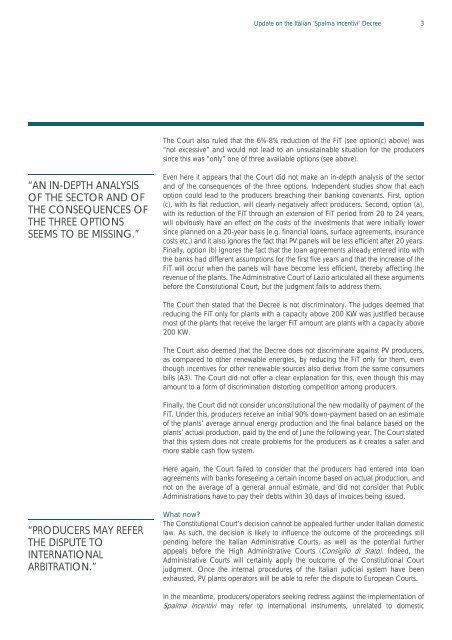UPDATE ON THE ITALIAN “SPALMA INCENTIVI” DECREE
yB2b308SJcy
yB2b308SJcy
You also want an ePaper? Increase the reach of your titles
YUMPU automatically turns print PDFs into web optimized ePapers that Google loves.
Update on the Italian "Spalma incentivi" Decree 3<br />
The Court also ruled that the 6%-8% reduction of the FiT (see option(c) above) was<br />
“not excessive” and would not lead to an unsustainable situation for the producers<br />
since this was “only” one of three available options (see above).<br />
“AN IN-DEPTH ANALYSIS<br />
OF <strong>THE</strong> SECTOR AND OF<br />
<strong>THE</strong> C<strong>ON</strong>SEQUENCES OF<br />
<strong>THE</strong> THREE OPTI<strong>ON</strong>S<br />
SEEMS TO BE MISSING.”<br />
Even here it appears that the Court did not make an in-depth analysis of the sector<br />
and of the consequences of the three options. Independent studies show that each<br />
option could lead to the producers breaching their banking covenants. First, option<br />
(c), with its flat reduction, will clearly negatively affect producers. Second, option (a),<br />
with its reduction of the FiT through an extension of FiT period from 20 to 24 years,<br />
will obviously have an effect on the costs of the investments that were initially lower<br />
since planned on a 20-year basis (e.g. financial loans, surface agreements, insurance<br />
costs etc.) and it also ignores the fact that PV panels will be less efficient after 20 years.<br />
Finally, option (b) ignores the fact that the loan agreements already entered into with<br />
the banks had different assumptions for the first five years and that the increase of the<br />
FiT will occur when the panels will have become less efficient, thereby affecting the<br />
revenue of the plants. The Administrative Court of Lazio articulated all these arguments<br />
before the Constitutional Court, but the judgment fails to address them.<br />
The Court then stated that the Decree is not discriminatory. The judges deemed that<br />
reducing the FiT only for plants with a capacity above 200 KW was justified because<br />
most of the plants that receive the larger FiT amount are plants with a capacity above<br />
200 KW.<br />
The Court also deemed that the Decree does not discriminate against PV producers,<br />
as compared to other renewable energies, by reducing the FiT only for them, even<br />
though incentives for other renewable sources also derive from the same consumers<br />
bills (A3). The Court did not offer a clear explanation for this, even though this may<br />
amount to a form of discrimination distorting competition among producers.<br />
Finally, the Court did not consider unconstitutional the new modality of payment of the<br />
FiT. Under this, producers receive an initial 90% down-payment based on an estimate<br />
of the plants’ average annual energy production and the final balance based on the<br />
plants’ actual production, paid by the end of June the following year. The Court stated<br />
that this system does not create problems for the producers as it creates a safer and<br />
more stable cash flow system.<br />
Here again, the Court failed to consider that the producers had entered into loan<br />
agreements with banks foreseeing a certain income based on actual production, and<br />
not on the average of a general annual estimate, and did not consider that Public<br />
Administrations have to pay their debts within 30 days of invoices being issued.<br />
“PRODUCERS MAY REFER<br />
<strong>THE</strong> DISPUTE TO<br />
INTERNATI<strong>ON</strong>AL<br />
ARBITRATI<strong>ON</strong>.”<br />
What now?<br />
The Constitutional Court’s decision cannot be appealed further under Italian domestic<br />
law. As such, the decision is likely to influence the outcome of the proceedings still<br />
pending before the Italian Administrative Courts, as well as the potential further<br />
appeals before the High Administrative Courts (Consiglio di Stato). Indeed, the<br />
Administrative Courts will certainly apply the outcome of the Constitutional Court<br />
judgment. Once the internal procedures of the Italian judicial system have been<br />
exhausted, PV plants operators will be able to refer the dispute to European Courts.<br />
In the meantime, producers/operators seeking redress against the implementation of<br />
Spalma Incentivi may refer to international instruments, unrelated to domestic



